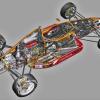The first roll-over bars
#1

Posted 28 October 2005 - 17:55
In Sweden the F3 cars had to have roll-over bars from the start in 1948. And a lot of the drivers used simple seatbelts too.
Advertisement
#2

Posted 28 October 2005 - 18:45
It is another thing entirely that the rollover bars used on F1 cars were criminally low and generally useless for many years afterwards - through all of the 60's, anyway.
#3

Posted 28 October 2005 - 19:48
#4

Posted 28 October 2005 - 19:59
At Indianapolis the 1957 Belond didn't have one while in 1958 the same car did, which suggests it may have come into the Indianapolis regulations that year
They seem to have been in US sports car racing in the fifties - I remember my Castrol Achievements of about 1958 showed them.
#5

Posted 28 October 2005 - 21:09
But where there any roll-over bars before World War II?
I think it is so fascinating that it took so long before people really did anything about safety.
When Swedish driver Severt Sundberg was killed when his Ferrari overturned in 1953, there was talk of a mandatory roll-over bar on all open cars in ice-racing. And some cars got one. But there were no rules.
Sture Selander was killed at Gardemoen in 1949 in an Effyh, that had a a roll-over bar like all Swedish F3s. He was thrown out and the car landed on him. After that race people said that he wouldn't have been killed if he had used a seat-belt, like some of the other guys. But no one seemed to learn anything from that.
#6

Posted 29 October 2005 - 09:57
The same for sprint cars. But the problem was that the rollbars were not very high so serious injuries and deaths were still quite common. To prevent this USAC introduced rollcages for 1970 or 1971.
#7

Posted 29 October 2005 - 14:42
#8

Posted 29 October 2005 - 18:24
#9

Posted 30 October 2005 - 21:07
#10

Posted 30 October 2005 - 21:59
#11

Posted 30 October 2005 - 23:05
#12

Posted 30 October 2005 - 23:05
Just an excuse to use the picture below: Robert Nellemanns 1949-1950 Silver Bird 500cc F3 car had the mandatory roll-hoop, and even a lap belt, but as may be seen, the driver didn't need to be particularly tall to have his head stand proud of the hoop. Still, it may have saved Nellemann from serious injury - he did roll the car (at least once), which explains the very much dented and skewed appearance of the car today, relative to the pristine, smooth bodywork seen in launch pictures before it was raced. Scandinavian Midgets had mandatory roll-hoops, which were even fitted to some of the later imported Coopers IIRC - certainly to the locally built copies.

#13

Posted 31 October 2005 - 03:31
In the 1920s (earlier?) there was a motorized version of polo done with a driver and rider on stripped down Model Ts. They also had big roll bars.
#14

Posted 31 October 2005 - 08:18
The thinking was that if you crash, and are thrown from a car, additional weight on your head will increase the chance of neck injuries. In the 1950s, you preferred death to life in a wheelchair.
It maybe was possible to be thrown out when you had those big open cockpits in the 50ies. But when they crept down in the small racers in the sixties, I wonder what they thought about. Is there anyone who knows if there were any talk about seatbelts after von Trips and Ricardo Rodriguez accidents?
And when they finally started to use rollbars, they put on those flimsy thin tubes. Probably the most promising Swedish Fjunior driver was killed, when his car oveturned in Helsinki in '63.
In Scandinavia we had roll-bars and seatbelts in the 500 F3s. But that was probably because they used to race on the small speedway ovals. Their ideas or rules were strangely not taken up in road racing. You could think that there is some sort of progress in the knowledge. But the Scandinavian F3 rules never became international and wasn't even followed up in national racing.
.In the 1920s (earlier?) there was a motorized version of polo done with a driver and rider on stripped down Model Ts. They also had big roll bars.
It seems as if the roll-bars first was used in places where the cars were likely to turn over. Racing cars was not intended to roll, so they didn't need any. Well, the drivers didn't have helmets either..
#15

Posted 31 October 2005 - 12:34
In Australia, CAMS did not require roll bar or seat belts as late as the 1966 season. In 1967 roll bars were required by photo evidence I have but can not confirm that seat belts came in at the same time but I believe that they did.
Regards
#16

Posted 31 October 2005 - 13:53
#17

Posted 31 October 2005 - 14:01
Interesting comment about 'Sissy bars'. Sir Stirling's father insisted he wore a crash helmet and the Greatest Living Englishman got huffy about it because he thought it was "Sissy". In recent years he has managed to persuade the FIA to allow him to race with one of his original-style skidlids, which was actually a polo helmet.
#18

Posted 01 November 2005 - 07:58
" Interestingly a contributor there immediately made the point that roll hoops and seat belts or safety harness should go together."
Too true. There was a thread recently asking about major technical contributions to car safety. I almost, tongue in cheek, was going to contribute that a 4 inch wide chrome drawer handle was such a major device.
As I noted above there were a number of years in the US where we had belts but not roll bars with terrible consequences from time to time.
One of the worst that I witnessed was Sebring 1957. Bob Goldich somersalted and end over ended a team Arnolt Bristol under those conditions. The Arnolt Bristol was one of the many cars of the day in which the driver sat about half above the body line. It was one of the most sickening sights that I have ever witnessed in action.
Driver's concerns for such things occuring in those days resulted in many fixing the aforesaid drawer handle to the floor of the passenger side so as to have something to hold on to and pull/hold oneself down in case of calamity. As if we really thought we had either time or strength to avail ourselves.
Ignorance and self belief was rampant.
#19

Posted 01 November 2005 - 09:00
Stirling Moss "managed to persuade the FIA to allow him to race with one of his original-style skidlids, which was actually a polo helmet".
It may have been but I doubt it. I have a photo of a helmetted Stirling, in 1948, in his F3 car.
He, we, felt very safe indeed in our Cromwell crash hats. The Cromwell was a cork "pudding bowl" with a leather covering and leather belting and string suspension inside. The leather exterior extended down over the back of the neck and under the chin for fixing. Easy to confuse with a polo helmet.
Such were the best we had until late in the Fifties, the California company, Toptex, came out with the first step towards modernity. The Toptex helmet had a hard plastic outer with energy absorbing, dissapating, load spreading interior. Still no back of neck protection and I rememnber it still having a suspension. Much better and besides it probably took about ten times the force to split.
In 1957 Dr Peter Snell lost his life to head trauma racing in California. Some of his medico friends realised that there were better things possible and put up the money for the first formal testing and development of helmets; the beginning of the Snell Foundation.
A little later, I think in the very early Sixties, Bell Helmets bought out Toptex, married technologies and came out with the first of the "modern helmets". These had the Toptex type technology but with a tight fitting, no suspension. They were open face though.
The first common use of closed face helmets came in 1970, though there may have been some limited use earlier, possibly 1969, but I have no reference to earlier than that. It wasn't long ago that I threw out my first Snell approved Bell closed face helmet away. The interior foam wasn't much chop by today's standards. Maybe I should have donated it to a museum.
Just to put things into historical perspective.
Advertisement
#20

Posted 02 November 2005 - 20:43
This is what one intelligent journalist wrote in June 1946:
" The drivers should be fastened with belts like those that are used in all aeroplanes. This fastening arrangement together with a strong roll-bar can save the driver's neck in an accident."
It took over two decades before F1 got it.
#21

Posted 02 November 2005 - 22:03
Maybe this is a cue to re-open the thread I started some time ago re the sentiment towards passive safety in the past?














